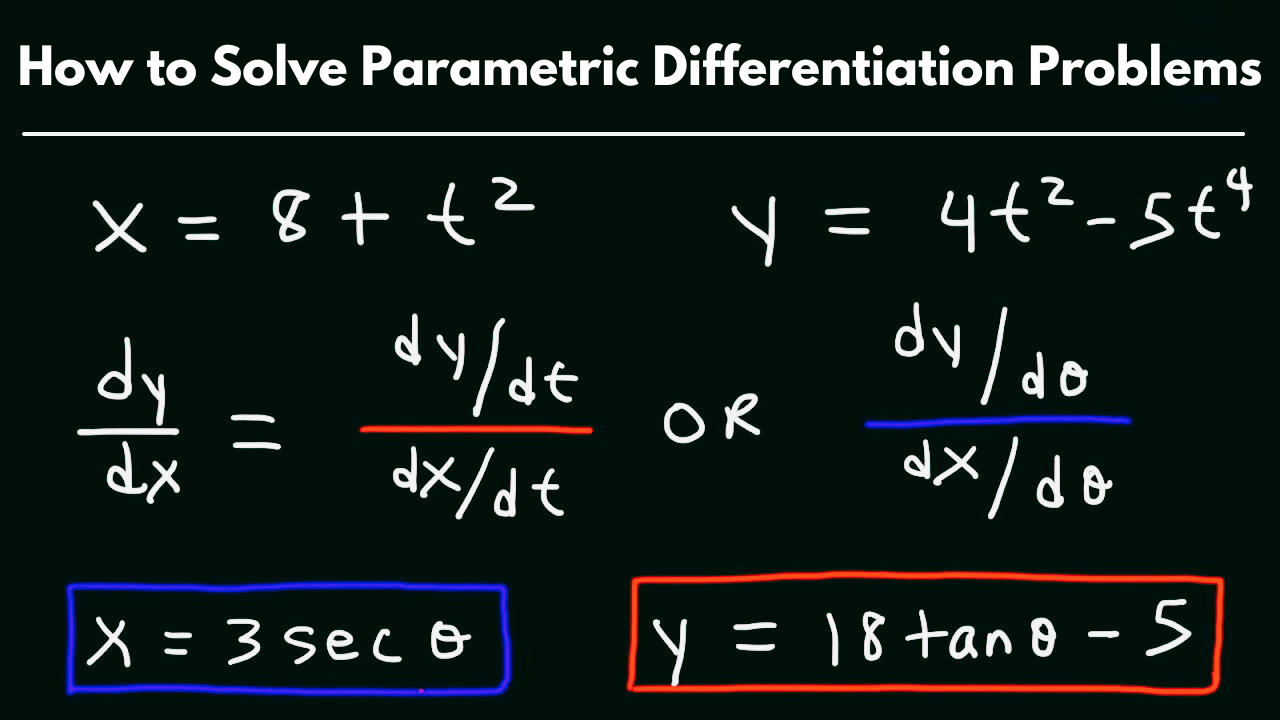Parametric differentiation is a crucial aspect of calculus that deals with finding derivatives of parametric equations. These equations describe curves using different variables for each coordinate. In this comprehensive guide, we will delve into the world of parametric differentiation, exploring its rules, applications, and problem-solving techniques.
Understanding Parametric Equations:
Parametric equations are a set of equations that express the coordinates of a point on a curve in terms of one or more parameters. For instance, for x and y coordinates, we use x = f(t) and y = g(t), where t is the parameter. To illustrate, consider the parametric equations of a circle: x = rcos(t) and y = rsin(t), where r represents the radius, and t varies from 0 to 2π. Understanding these equations is fundamental before diving into parametric differentiation.
Related: What Are The Applications And Importance Of Mathematics
Basic Rules of Parametric Differentiation:
Parametric differentiation involves finding the derivatives of x and y with respect to the parameter t. To do this, we utilize the chain rule. For instance, given x = f(t) and y = g(t), we find dx/dt and dy/dt by differentiating f(t) and g(t) individually. For example, if x = 2t² and y = 3t – 1, then dx/dt = 4t and dy/dt = 3.
How to Solve Parametric Differentiation Problems
Parametric differentiation involves finding the derivatives of parametric equations, which describe curves using different variables for each coordinate. To solve parametric differentiation problems, and find the derivative of parametric functions, follow these step-by-step instructions:
Related: Gauthmath App – How To Get Math Problems Solved Instantly?
Step 1: Identify the Parametric Equations
Begin by identifying the given parametric equations for x and y, usually represented as x = f(t) and y = g(t). These equations define how the x and y coordinates change with respect to the parameter t.
Step 2: Find dx/dt and dy/dt
To find dx/dt and dy/dt, differentiate the parametric equations with respect to t using the chain rule. Individually differentiate f(t) and g(t) to calculate dx/dt and dy/dt, respectively.
Step 3: Simplify the Derivatives
Simplify dx/dt and dy/dt by simplifying the expressions obtained from Step 2. Sometimes, this may involve combining terms or applying algebraic manipulations.
Step 4: Derive dy/dx (if necessary)
In some cases, you may need to find the derivative dy/dx when both x and y are given as functions of t. To do this, use implicit differentiation. Differentiate both x = f(t) and y = g(t) with respect to t and then solve for dy/dx.
Step 5: Interpret and Apply
Interpret the derivatives obtained in Steps 2 and 4 as rates of change and slopes at various points on the curve. Use these derivatives to analyze the behavior of the curve, find tangent and normal lines, or solve specific problems related to the parametric equations.
Step 6: Check for Accuracy
Always double-check your calculations and interpretations to ensure accuracy. Parametric differentiation involves multiple steps, so it’s essential to avoid computational errors.
Step 7: Practice and Familiarize
To improve your proficiency in solving parametric differentiation problems, practice various examples and explore different types of parametric curves. Familiarity with various cases will boost your problem-solving skills.
Example:
Let’s work through an example to illustrate the steps:
Given parametric equations:
x = 2t + 1
y = 3t² – 2t
Step 1: Identify the parametric equations:
x = 2t + 1
y = 3t² – 2t
Step 2: Find dx/dt and dy/dt:
dx/dt = d(2t + 1)/dt = 2
dy/dt = d(3t² – 2t)/dt = 6t – 2
Step 3: Simplify the derivatives:
dx/dt = 2
dy/dt = 6t – 2
Step 4: Derive dy/dx (if necessary):
To find dy/dx, divide dy/dt by dx/dt:
dy/dx = (6t – 2) / 2 = 3t – 1
Step 5: Interpret and Apply:
The derivatives dx/dt and dy/dt represent the rates of change of x and y with respect to t. The derivative dy/dx represents the slope of the curve at any point.
Step 6: Check for Accuracy:
Ensure that the calculations are correct and verify the interpretations of the derivatives in the context of the problem.
Step 7: Practice and Familiarize:
Continue practicing similar examples to gain confidence in solving parametric differentiation problems.
Higher Order Derivatives in Parametric Equations:
Once we grasp the basic differentiation rules, we can extend the concept to higher-order derivatives. To find d²x/dt² and d²y/dt², we differentiate dx/dt and dy/dt, respectively. This allows us to understand the curvature and acceleration of a parametric curve at different points.
Example
Consider the following parametric equations:
x = 3t² + 2t
y = 5t – 1
To find the higher-order derivatives, we will start by finding the first-order derivatives:
dx/dt = d(3t² + 2t)/dt = 6t + 2
dy/dt = d(5t – 1)/dt = 5
Next, let’s find the second-order derivatives:
d²x/dt² = d(6t + 2)/dt = 6
d²y/dt² = 0 (since the derivative of a constant is zero)
So, the second-order derivatives for the given parametric equations are:
d²x/dt² = 6
d²y/dt² = 0
Implicit Differentiation with Parametric Equations:
In some cases, we may encounter situations where both x and y are given as functions of t, but not explicitly. This is where implicit differentiation comes into play. By differentiating both sides of the equation and isolating dy/dx, we can find the slope of the curve without solving for y explicitly.
Example
Consider the parametric equations:
x = 4cos(t)
y = 2sin(t)
Now, let’s find dy/dx using implicit differentiation. We need to differentiate both x and y with respect to t and then solve for dy/dx:
Differentiate x = 4cos(t) with respect to t:
dx/dt = -4sin(t)
Differentiate y = 2sin(t) with respect to t:
dy/dt = 2cos(t)
Now, to find dy/dx, divide dy/dt by dx/dt:
dy/dx = (2cos(t)) / (-4sin(t))
dy/dx = -0.5cot(t)
So, the derivative dy/dx for the given parametric equations is:
dy/dx = -0.5cot(t)
Tangents and Normals to Parametric Curves:
Finding tangent and normal lines to a parametric curve is crucial in understanding the behavior of the curve at specific points. By calculating slopes and using the point-slope formula, we can determine the equations of these lines. This concept finds applications in various fields like engineering, computer graphics, and physics.
Example
Consider the parametric equations:
x = 2t² + 3
y = 3t – 1
To find the equation of the tangent line to the curve at t = 2, we follow these steps:
Find dx/dt and dy/dt:
dx/dt = d(2t² + 3)/dt = 4t
dy/dt = d(3t – 1)/dt = 3
Calculate the slope of the tangent line at t = 2:
m = dy/dt at t = 2
m = 3 (substitute t = 2)
Find the point on the curve at t = 2:
x = 2(2)² + 3 = 11
y = 3(2) – 1 = 5
Write the equation of the tangent line using the point-slope form:
y – y₁ = m(x – x₁)
y – 5 = 3(x – 11)
y – 5 = 3x – 33
y = 3x – 28
So, the equation of the tangent line to the curve at t = 2 is:
y = 3x – 28
Parametric Differentiation of Polar Equations:
Sometimes, it is more convenient to represent curves using polar equations. To differentiate polar equations with respect to t, we convert them into parametric form first. Then, we follow the usual parametric differentiation process to find dx/dt and dy/dt.
Example
Consider the polar equation of a circle:
r = 2a cos(θ)
To differentiate the polar equation with respect to θ, we need to convert it into parametric form. For this, we use the relations:
x = r cos(θ) and y = r sin(θ)
Substitute the value of r from the given polar equation:
x = 2a cos(θ) cos(θ) = 2a cos²(θ)
y = 2a cos(θ) sin(θ) = a sin(2θ)
Now, we have the parametric equations:
x = 2a cos²(θ)
y = a sin(2θ)
Next, let’s find dx/dθ and dy/dθ:
dx/dθ = d(2a cos²(θ))/dθ = -4a cos(θ) sin(θ)
dy/dθ = d(a sin(2θ))/dθ = 2a cos(2θ)
So, the derivatives dx/dθ and dy/dθ for the given polar equation are:
dx/dθ = -4a cos(θ) sin(θ)
dy/dθ = 2a cos(2θ)
Parametric Differentiation in Physics and Engineering:
The applications of parametric differentiation are far-reaching in the fields of physics and engineering. From understanding the motion of particles to analyzing projectile motion, parametric equations play a vital role. Real-world examples and case studies illustrate their significance.
Conclusion
Parametric differentiation is a valuable tool that allows us to understand and analyze complex curves represented by parametric equations. By mastering this concept, you gain insights into various fields of science and engineering, making it an essential topic for any calculus enthusiast.
FAQ
Q: What are parametric equations?
A: Parametric equations are a set of equations that describe points on a curve using one or more parameters, such as x = f(t) and y = g(t).
Q: Why is parametric differentiation important?
A: Parametric differentiation helps us find the derivatives of parametric equations, which are crucial for understanding the behavior of curves.
Q: How do I differentiate polar equations?
A: Convert polar equations to parametric form first, then differentiate them with respect to t.
Q: Where do we use parametric differentiation in physics?
A: Parametric differentiation finds applications in analyzing motion, projectile motion, and other related physics problems.
Q: How can I avoid common mistakes in parametric differentiation?
A: Pay attention to chain rule applications, be careful with implicit differentiation, and practice regularly to avoid common errors.




